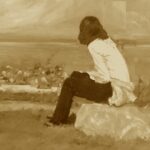In the 1990s, in my home office at the time, I had two paragraphs posted on a bulletin board near my desk, cut out of some newspaper article I’d read at some point. The first paragraph was a quote from Agnes De Mille, about her perspective when she was 36.
At night in the little personal hours I did the dreadful arithmetic. Youth gone. No husband. No child. No achievement in work. I used to wake up cold and consider the situation. Time was passing. My prospects had over a decade ago ceased to be bright.
The next paragraph noted that, a year after this thought, she was a legend because of Rodeo, and choreographing Oklahoma, which would cement her status as an icon of the arts.
I never knew Agnes de Mille was a failure before Rodeo. I grew up knowing that name as legend, as stellar success. The article had both jolted me and inspired me, as I was having a hard time of it myself right at that moment, so I had kept that quote nearby, to give me hope.
I lost that newspaper cut out in a move, and I couldn’t remember the wording well enough to find it online. So I decided I would read her entire autobiography, Dance to the Piper, to find it.
I got so much more than that quote.
I’m not a dancer. When I was a little girl, I thought that people who became professional dancers were born into a family of dancers, and were born in New York, and as this wasn’t my circumstance, it never, ever dawned on me that I could enjoy dancing, that it wasn’t just some silly pretend thing. I thought people were born into their adult professions or college athletic aspirations – doctors were the sons and daughters of doctors, teachers were the children of teachers, basketball players came from families where others had played at the college level before them. My Mom put me into a dance school when I was young, probably about 6, but I thought it was just something she wanted me to do so I would be out of the house, and I thought I couldn’t be a real dancer anymore than I could be a doctor – I wasn’t born in the right place, to the right family. I didn’t really try to do well in class, to learn anything or even to enjoy what I was doing, because I never knew that this is how you become a dancer: by dancing. In fact, I thought the people around me in my family and at school and in my neighborhood thought dancing was silly, and being young and profoundly insecure, what people might be thinking kept me from attempting oh-so-many things as a kid. I’m not sure I’d even seen ballet on TV at that point, other than as a joke on a variety show or daytime rerun. That this barre work in a little dance studio in a converted house on Main Street in Henderson, Kentucky was the same all over the world, and I could be part of a beautiful, glorious tradition merely if I wanted to be, at least while I was in these classes, never dawned on me.
But, as a kid, I loved seeing live performance, and before I was a teen, those live performances were in grade school cafeterias and church fellowship halls and sanctuaries. I loved those simple shows about Jesus or history or whatever. When I was about 14, the Berea College Dancers and the Louisville Ballet company did performances in the gym at South Junior High School, and I sat trembling in the bleachers as I watched those dancers. I was realizing at last that, indeed, you could be a performer in Kentucky, an artist, even a dancer. But I was too old to think about studying dance, and I deeply regretted not knowing, not understanding, that I could have taken it seriously back when I was 6.
Agnes de Mille, as a child, saw the legendary dancer Anna Pavolva. And, so, she understood the possibilities even at a tender age.
I had witnessed the power of beauty, and in some chamber of my heart I lost forever my irresponsibility. I was as clearly marked as though she had looked me in the face and called my name.
That moment as a child seeing such artistry set her on a path that brought her so, so much disappointment. She put on pageants in her backyard and committed to the craft completely, despite her parents, especially her father, trying to talk her out of it. She did not have a dancer’s body by birth – so she created it by work and practice.
I bent to the discipline. I learned to relax with my head between my knees when I felt sick or faint. I learned how to rest my insteps by lying on my back with my feet vertically up against a wall. I learned to bind up my toes so that they would not bleed through the satin shoes. But I never sat down. I learned the first and all-important dictate of ballet dancing – never to miss the daily practice, hell or high water, sickness or health, never to miss the barre practice; to miss meals, sleep, rehearsals even but not the practice not for one day ever under any circumstances, except on Sundays and during childbirth… My calves used to ache until tears stuck in my eyes. I learned every possible manipulation of the shoe to ease the aching tendons of my insteps. I used to get abominable stitches in my sides from attempting continuous jumps. But I never sat down. I learned to cool my forehead against the plaster of the walls. I licked the perspiration off from my mouth. I breathed through my nose though my eyes bugged. But I did not sit and I did not stop.
She was a full-figured teen at a time when boyish figures were the rage. She had a head full of curls at a time when girls wore their hair as straight as possible.
I received an anonymous note at school suggesting I wear tighter underclothing. I was couched in French, in the interest of delicacy. I did not get over that note in a hurry.
The negative comments were crushing – but she persisted. She studied, she practiced every day, she traveled to London, she put together recitals, she collaborated, she performed, she experimented, she invented, and, again and again, she played to empty houses when she tried to put together a paying audience. She had newspapers praise her, but it never turned into a paid success. She would have a producer tell her she was brilliant and that he would bankroll a tour, and in the end, she would end up financing the entire production and tour and dance her heart out and lose all the money she had borrowed. She and her mother designed and sewed all of her costumes herself. She borrowed clothes to wear day-to-day outside of dancing. Yes, her uncle was Cecil de Mille, but Cecil wasn’t rolling in dough, despite directing Hollywood spectacles. There was no fortune to back her. It is amazing to think of her and her mother mixing with Hollywood royalty and, yet, being on the brink financially.
Agnes de Mille was frequently cheated out of money. She was cold and hungry a lot. She kept dancing, but every promising career turn fizzled. She even landed a much-needed, high-profile job, choreographing the dance scenes in Romeo and Juliet starring Leslie Howard and Norma Shearer. But her hard work was largely ignored in the film, hidden in the closeups of the stars, and no one wanted to work with her again. She went back to trying to be a dancer. She made sure she was in the company of great dancers. She kept dancing and creating. She and her colleagues were creating amazing work – and no one was watching.
Let’s repeat that thought of Agnes de Mille that opened this:
At night in the little personal hours I did the dreadful arithmetic. Youth gone. No husband. No child. No achievement in work. I used to wake up cold and consider the situation. Time was passing. My prospects had over a decade ago ceased to be bright.
It was 1942. She was giving up. Her mother had had a stroke and was barely getting by financially, largely because of the money she had given her daughter in pursuit of her dancing dream. As she notes in her autobiography:
I had been given a fair long chance to prove my mettle, and I seemed only to drain off her resources dollar. Plainly I hadn’t made good. But I had done my utmost. I must rest on this and accept God’s will. There was however one further thing I could do. I could quit.
I intended to go down to Macy’s, where Mag (her sister), now divorced, had been learning merchandising, and get a job at a ribbon counter or wherever they’d take me and earn a stipulated weekly salary, no matter how small. I would not continue to wear my sister’s cast-off clothes aas I had done for the past eight years. I would budget myself and live on my own earnings. At the end of a year I would be able to hand in an income tax – something I had done only one in my life. Or – I had heard there was to be a women’s branch of the army –
And here’s what’s so awesome about this moment when she gave up: this feeling of absolutely nothing left to lose gave her a mental and emotional freedom that allowed her, ultimately, to succeed. She stopped wondering about what people thought of her. She stopped being self-consciousness. She got a fuck it attitude. She continued to practice her craft, but it was more out of habit, and just to enjoy it. Her ambition was gone – only love of dance remained.
But on the street one day, before she’d made it to Macy’s to apply for a job, she met someone who told her the oh-so-snooty Russian Ballet, ever-touring the USA, wanted the novelty of having an American ballet by an American, and they were considering her. And the fuck it attitude of Agnes de Mille, her I’m going to work at Macy’s after this final failure belief, was her strength that lead to triumph. And it started in her first meeting with the Russians:
Although the situation I found myself in was ornate and rich with treacherous personalities, I had these advantages:
- I said just what I meant which baffled the Russians to a standstill and set them to figuring at length what lay behind my seeming Naïveté. Nothing lay behind it. But they didn’t realize this for several years. I was to them a figure of mystery.
- They spoke Russian so I could not understand their objections
- I thought they were a down-at-heel, shabby company who had got by with hokum for far too long, so I was not hampered by awe or any such restricting emotion.
- I believed that I could do something good.
- This was to be my last job so it didn’t matter anyway.
On the bus home from that first meeting with the Russians, she had a chance meeting with her friend, idol and mentor, Martha Graham. She told her what was happening. Here’s what Martha told her:
You be arrogant. You’re every bit the artist any one of them is. This they won’t know because they don’t know art from a split kick, but they will recognize arrogance, and for your sake, for our sakes, show them what it is like once in a way to be on the receiving end. They won’t respect you unless you’re rude.
Clearly, Martha would also know what it’s like to work with Silicon Valley types – rich with treacherous personalities.
I cried several times during this book, especially the last four chapters.
At 52, I’m relatively sure I’ve peaked professionally and that there are no more high profile, highly-influential jobs before me. I don’t think that, on my way to the movie theater in the next town to apply for a job tearing tickets and cleaning bathrooms, I’m going to run into a colleague I’ve worked with in the past who will say, “Hey, we’re got this idea for a project and we think you would be great to run it.” In fact, that did happen to me, online, rather than on a bus, back in 1996, when I was offered the Virtual Volunteering Project, and a certain quote from Agnes de Mille was posted on the bulletin board next to my desk and computer.
My legacy is tiny compared to Agnes de Mille, and though it was every bit as pioneering as some of the people I see celebrated now as tech4good pioneers, it is largely forgotten. But I know what it did, I have heard the personal, sometimes emotional stories of people who feel my research and advocacy changed them and their organizations. And that’s enough for me. I don’t care if anyone else knows it – I know it. And I cherish it.
Dance to the Piper has reminded me about the importance of personal and professional integrity, even when things aren’t going so well personally and professionally. Of celebrating the good stuff, the daring stuff, you are doing in your work and life, even when no one else does. Agnes de Mille danced like the world was watching, even when the house was empty, and she worked to be the greatest dancer and choreographer – the greatest professional — she could be. That hard work and dedication did pay off in the end, so while she was a professional failure for so many years, she was never an artistic or personal one. Had she not triumphed professionally in the end, had her genius not been recognized, would she have been in perpetual mourning for the rest of her life of what might have been? Maybe. I prefer to think she would she have looked back with fondness at the incredible experience she had, the time in rehearsals and on stage, and said, “I am glad I did it, nonetheless.”












Leave a Reply